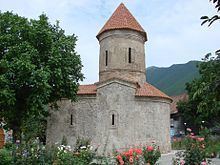Completed 12th-13th century | Ecclesiastical or organizational status inactive | |
 | ||
Similar Palace of Shaki Khans, Saint Maryam Church, Artavazik Church, Saint Karapet Church - T, Ptghnavank | ||
Ki alban m b di church of kish
The Church of Kish (Azerbaijani: Kiş kilsəsi), also known by different sources as Church of Saint Elishe (Azerbaijani: Müqəddəs Yelisey kilsəsi, Armenian: Սուրբ Եղիշէ եկեղեցի) or Holy Mother of God Church (Armenian: Սուրբ Աստուածածին եկեղեցի), is an inactive 12th or 13th century Caucasian Albanian church located in the village of Kiş approximately 5 km north of Shaki, Azerbaijan. It has functioned at different times as a Caucasian Albanian Apostolic church a Chalcedonian church within the Georgian Orthodox Church and later as Armenian Apostolic Church.
Contents
History
According to the 7th century Armenian historian Movses Kaghankatvatsi, in the 1st century AD St. Elishe, a disciple of Thaddeus of Edessa, arrived to a place called Gis (Գիս), where he built a church and recited a liturgy. The church became the "spiritual center and the place of enlightenment of people of the East". On his way from Gis St. Elishe was killed near the pagan altar in the small Zerguni valley by unknown people.
According to the Armenian historian on architecture Samvel Karapetian, the geographical position of Kish does not seem to match that described by Kaghankatvatsi. Karapetian believes that they have identified Gis as the village of Bomen/Bum 60 km to the south-east of Kish, in Gabala district.
According to a Georgian historiographer, in the 10th century, the population of Kish converted to the Georgian Orthodox Church (Chalcedonism). The church of Kish was turned into a residence of a Georgian bishop, functioning till 17th century. By the time when Russia took possession of the region the village of Kish had Udi population. According to Robert H. Hewsen, the Udi language appeared to have been prevalent north of Kura River until the nineteenth century, and the Armenian population appeared to be of relatively recent arrival. While many Armenians undoubtedly settled there fleeing the Turko-Mongolic invasions, many more entered the region with the coming of the Russians in the early nineteenth century.
In 1836, the Albanian church, along with all active churches in this region that were not Georgian or Russian, was incorporated into the Armenian Apostolic Church, and the Church of Kish was refounded in 1860s and became a place of pilgrimage due to the belief that it was associated with Elishe (Yegishe).
Research and dating
In 2000-2003 the Norwegian Ministry of Foreign Affairs funded a joint project between Azerbaijan Architecture and Construction University and the Norwegian Humanitarian Enterprise for the archaeological research and restoration of the church of Kish. Dr. Vilayat Karimov of Baku's Institute of Archaeology and Ethnography served as the director of excavations, and the archaeological advisor for the project was J. Bjørnar Storfjell. Radiocarbon analysis of various objects found on the site showed that the cultic site found beneath the altar of the church dates to about 3000 B.C., while the construction of the existing church building dates to about the 12th century (990-1160 A.D.)
The existing church building cannot be dated to the times of St. Elishe, but the archaeological evidence demonstrates that the church is located on an ancient cultic site. It is very unlikely that St. Elishe built in Kish a church in the modern understanding of this word. Even if the person did exist, it appears likely that he built only the altar or used an existing pagan cult structure.
Bjørnar Storfjell stated that there's clear evidence that this church was built as Diophysite church. Excavations revealed that the church represented two different periods of use, with two different corresponding floor levels. According to Storfjell, since the architecture of the apse of the original church in Kish suggests a diophysite Christology, and since the Georgian Church was the only diophysite church existing in the Caucasus in the late medieval period, it seems reasonable to suggest that the Kish church was built as a Georgian church and was later taken over by monophysites.
